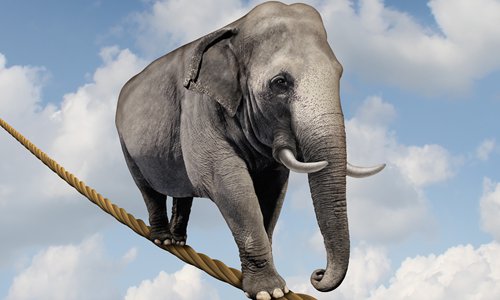
By Ding Gang (Global Times, 11 September 2019) – While scholars in the US and India generally believe that a full alliance between the two sides is unlikely, the two countries can still reach a general consensus on balancing the rise of China, since it is in their common interest.
In an article titled “The India Dividend: New Delhi Remains Washington’s Best Hope in Asia,” which was published in the September/October edition of Foreign Affairs magazine, authors Robert D. Blackwill, a Henry A. Kissinger senior fellow for US foreign policy at the Council on Foreign Relations, and Ashley J. Tellis, senior fellow at the Carnegie Endowment for International Peace, noted that for the US-Indian partnership to bear fruit, both sides must recognize that their primary shared interest is to balance a rising China – and not expect a close alliance or alignment on all major policy issues.
The Indian government hasn’t explicitly announced it was adopting such a strategy to balance the rise of China, but there are indications that India and the US are moving forward on this path.
The balance of power theory in international relations suggests that if a country wants to prevent itself from being dominated by others, it must have the power or a reliable system to counterbalance others. The theory emphasizes vigilance and containment between different countries.
In reality, balance of power is usually utilized by a certain powerful country to make coalitions or military alliances to counter its rivals – the balance of power during the Cold War is a classical example. Additionally, such a balance is likely to develop into hostility.
Amid the rise of China in recent years, some Americans have brought up again the balance of power theory. Washington’s strategic choice on China has also turned from balancing to containing China. The US Indo-Pacific Strategy is sure to continue this mentality.
There is something in common between the Indo-Pacific Strategy and India’s concerns about China’s rise.
China and India have had disputes in the past and still have border issues to settle. Additionally, China has maintained a close relationship with Pakistan, India’s traditional rival.
New Delhi wishes to safeguard its interests in a relatively balanced regional situation through a balance of power with Beijing. This is understandable.
However, the balance of power which India hopes for is different from that upheld by the US. The US’ so-called balance of power is aimed at keeping its dominance in the Asia-Pacific region and containing China.
After World War II, some Asia-Pacific countries have indeed enjoyed relative stability under the US-dominated order. But the structure of the region is changing. The rise of China is only a part of the changes. India and Southeast Asian countries are also rising, and they are accelerating the process.
Another major change is constantly upgrading regional cooperation. New Delhi is strengthening its cooperation with its neighbors, and it has thus developed the Look East policy. China’s cooperation with neighboring countries, including India, has also seen unprecedented strengthening. Amid such changes, there is no foundation for the outdated balance of power theory. No force is able to stop the Chinese economy from developing. China’s rising strength will certainly change the structure of the Asia-Pacific region, and cannot be balanced by either outside forces or military powers. Regional countries need to build a new order.
Balancing China will jeopardize India’s own interests. Since China’s development is unstoppable and is in line with the general development of the region, carrying out containment against China is highly likely to lead to the loss of opportunities for cooperation with China.
India should think this through. It is impossible for regional countries to jointly contain China’s rise with the US while strengthening cooperation with China at the same time. Such a strategy might work at the very beginning, but at critical moments, relevant parties will have to make a choice.
The strategy of the balance of power is generated from the diplomacy of Western countries. It reflects Western countries’ understanding of foreign relations in the process of their expansion in the past. In today’s globalized world, Asian countries are supposed to have better choices. This is a test for not only for India, but also China. Both need work together to walk out of this strategic trap.
The author is a senior editor with People’s Daily, and currently a senior fellow with the Chongyang Institute for Financial Studies at Renmin University of China. [email protected]. Follow him on Twitter @dinggangchina

